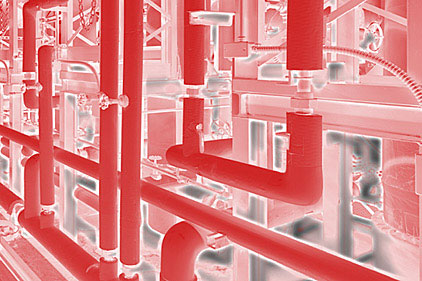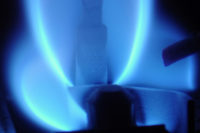Modular boilers were reportedly first introduced in the 1960s. They were quickly seen to reduce system energy losses, improving system efficiency with better load matching, and providing great turndown ratios with better controllability, too. The basic concept of modular boilers is that they are smaller-capacity packaged units that operate in parallel or series to provide varying amounts of heating water. In general, modular boilers are installed in banks of two or more boilers to meet a building’s part-load and peak demands for heating water.
The concept of a modular boiler is continually growing in the building industry for good reasons. Not only can modular boilers be right-sized to help provide the appropriate heating water needed to match the heating loads of a building throughout the day in new construction, but they can do well in retrofits, too. Load-matching with modular boilers is one of the best ways to save energy.
The modular boilers discussed here are condensing boilers. A condensing boiler condenses the water vapor produced in the combustion process and then uses the heat from this condensation. The annual fuel utilization efficiency (AFUE) rating for a condensing boiler can be 10% or more than a non-condensing boiler. Condensing boilers generally cost more than non-condensing models; however, condensing boilers can save fuel costs over the 15- to 30-year life of the units. As with other products, the life of a modular boiler is dependent on usage and maintenance. By designing a system with multiple modular boilers, the life of each boiler can be extended by using a duty-cycle strategy in the system design.
Boilers, like other types of equipment, are usually most efficient when operated at full capacity. Under part-load demand, the boiler output is turned down to less than full capacity. At part-load operating conditions, the efficiency is diminished. The modular boiler concept allows the boilers that are in operation to be run at higher efficiencies.
Modular boilers can also provide multiple levels of redundancy for a large facility at smaller incremental first costs than if two or three larger boilers were used instead, with only one for standby purposes.
DESIGN CONSIDERATIONS
The 2012 ASHRAE Handbook HVAC Systems and Equipment states, “The design engineer is responsible for considering and recommending various systems and recommending one or two that will meet the project goals and perform as desired.” Defining the desire of the client is part of the engineering process. The system selection criteria includes such considerations as capacity based on local climate, building design and use, redundancy, space requirements, security concerns, first cost, operational costs, maintenance costs, reliability, flexibility, life-cycle costs, sustainability, acoustical considerations, and others based on project specific demands.
Engineers will generally provide multiple units of heating equipment for a few reasons. One is for efficiency of operation, and another is for standby and redundancy depending on the critical nature of the building systems, based on occupancy type and climate conditions at the building location.
When larger boilers are in standby mode, they still maintain a certain temperature, and this allows flue gas heat losses all the time. With modular boilers not in use, the boiler is simply off, so there are no such losses.
Due to the fact that the heating system design and equipment specifics affect many engineering and architectural disciplines, the decision to use or not use modular boilers needs to be made early in the schematic design process, or even earlier in discussions of project scope with the building owner. The architect needs to be involved to understand whether the equipment will be installed in one central location with distribution piping run through chases and shafts, or if smaller units will be installed in smaller rooms strategically located to minimize distribution piping. Combustion air intakes and exhaust piping locations need to be coordinated with the building design to meet the codes and standards. The owner needs to understand the impact of the equipment layout in order to plan the maintenance procedures if occupied spaces need to be crossed to reach the equipment locations. This can be a major concern in laboratories, health care facilities, critical environment facilities, and other facilities with secure areas.
When building loads are calculated for heating of a building, there needs to be sufficient total capacity to take care of the required loads at the peak heating periods. However, these periods are generally a very small segment of the total occupied hours of a building. The installation of large boilers that may be sized to cover the peak demands of a building can cause excess energy usage in the part-load times of the year. Losses from inefficient operation of the boiler and from stack losses are two areas in which modular boilers can outperform older traditional boilers used in many buildings.
Professional engineers work hard to properly right-size the equipment they select and specify based on the cooling and heating loads of a building. This process may seem simple to those who have never been in responsible charge for doing such a building load analysis. The number-crunching can be straightforward, but predicting a building’s peak and part-load demand at any given time of the year is not always so precise. Many factors are involved with predicting and calculating how much energy is needed at any given time to heat a building. The design-phase calculation is based on theory; however, when the building is built, the construction quality can alter the building cooling and heating demand from the equipment substantially.
FEATURES/BENEFITS
When it comes to making product selection decisions, an engineer and the facility owner/client are weighing the features/benefits of products and systems compared to the product cost, installation cost, fuel, and maintenance costs. The total installed cost and the lifecycle cost of a product are becoming increasingly important criteria as codes and standards are more demanding and fuel prices continue to rise. Although engineering judgment and analysis may indicate that modular boilers are the best system for a given facility, the enduser is often swayed by looking at the simple first cost of materials. This is often shortsighted, but budgets sometimes dictate such prioritizing.
High-efficiency boilers have condensing flue gases in a second heat exchanger for extra efficiency, with sealed combustion and 90% to 98% AFUE.
Why would someone consider a modular boiler in lieu of traditional larger boilers? This list of considerations is not all-inclusive, and engineers and facility owners may have other features/benefits they consider important for their specific applications.
- Less installation space.
- Lower-temperature flue gas that can be exhausted directly out a sidewall.
- Less flue gas piping of smaller size.
- Less flue gas pipe heat loss.
- More efficient operation.
- Greater turndown ratios to better match building part-load demands.
- Easier maintenance and parts replacement.
- Smaller and lighter product for easier installation through standard doors.
- Generally lower total installed cost than larger boilers.
- Greater redundancy opportunity when properly sized based on building load demands.
- Flexibility and greater adaptability for future building retrofits.
MAINTENANCE
One of the biggest benefits to modular boilers is the simplicity of the product for maintenance. When it comes to product selection criteria, maintainability is one factor that engineers discuss with endusers. More and more, maintenance staff budgets are being cut, and that has a bearing on the level of expertise within a maintenance staff. Modular boiler designs have nearly come to a plug-and-play status when it comes to parts replacement and ease of maintenance and self-diagnostic controls.
A FITTING OPTION
The challenge in retrofitting older heating water boiler systems is the installation of new boilers through limited access in buildings. Old boilers that have exceeded their useful life can be dismantled and removed with minimal disruption of the building operation and structure. However, the installation of new units is more challenging if access for larger equipment wasn’t planned into the original building design. Newer modular boilers provide a huge advantage when it comes to retrofits due to the fact that their compact size allows product delivery to existing spaces through standard doors and elevators.
CONCLUSION
Modular boilers offer several advantages to an enduser, in areas ranging from maintenance to energy to comfort control. Another side benefit for modular boilers is the reduced space required compared to larger older boiler styles. Less access space is generally needed along with less floor space, which is a first cost benefit for new buildings. For retrofit projects, the modular boilers can generally be moved into the building through standard doors, thus eliminating the need to tear out walls for installation of larger boilers.
The application flexibility and future adaptability of modular boilers can be incorporated into any hydronic system for new and retrofit commercial facilities and residential applications, too. These include, but are not limited to, radiant floor heating, baseboard radiators, wall radiators, and heating coils in terminal units and air handlers.
Staged operation and properly operated right-sized boilers have many benefits for any size or type of building. This is a “Keep It Simple” opportunity for the owner. Manifolding of modular boilers and properly designed water distribution systems to the equipment using the hot water provides not only energy savings but simplified maintenance and backup cold start redundancy as compared to conventional boiler plants.





-Air-to-Water-Heat-Pump-Model-AXM.png?height=200&t=1663173619&width=200)